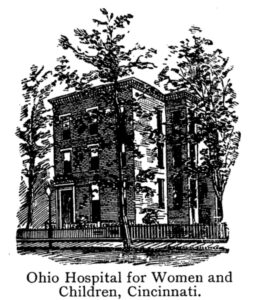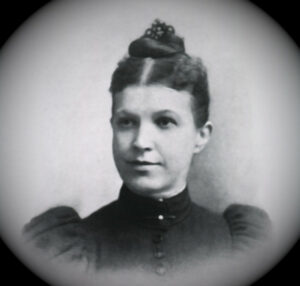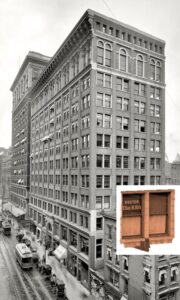(See also Women Doctors in Cincinnati and their Connections to Walnut Hills.)
We have seen that Elmira Howard, a member of the first class at the “Women’s Medical College of the New York Infirmary” (founded by Walnut Hills sisters Elizabeth and Emily Blackwell) came to Cincinnati in 1870 and established a successful practice in our city. Two more MDs arrived in Cincinnati from the Women’s Medical College in about 1877. Drs. Ellen M. Kirk and Martha May Howells (often referred to as May Howells) followed Dr. Howard in opening private practices in offices in downtown Cincinnati. Dr. Howells had grown up in nearby Hamilton, Ohio; it is not clear to what extent the New York Medical College connection with Cincinnati may have directed her here or to what extent she just “came home.” At any rate at least two sisters joined her in her downtown Cincinnati residence within a few years of her settling here.
Like the Blackwell sisters, Drs. Kirk and Howells shared a deep bond. As medical students in New York the two were apartment mates; one is left to wonder about the exact nature of intense friendships between single women living together in the later nineteenth century. Neither of them ever married. A near-contemporary account related:
“Where shall we settle?” was the question of questions when the graduation exercises had concluded, and the matter of the establishment of a practice had become the next thing in order. They discussed it on the street cars, over restaurant tables, in their rooms, after they had gone to bed at night, and before they rose in the morning.
“‘Well, I’m going to Cincinnati,’ at last decided Miss, now Dr. Howells.
“‘I’ll go too,’ decided Miss, now Dr. Kirk. So it was settled that the two young doctors should settle in Cincinnati, but that they should occupy separate offices, and each one propel her own skiff, or words to that effect.
“The fall of 1878 saw the young doctors neatly officed and with a good start toward a remunerative practice, which has grown larger from year to year, till now they have as large a practice as they can well attend to.”
In this, Drs. Kirk and Howells very much followed the example of Dr. Elmira Howard. Their class of 1876 apparently spent another year in New York for clinical training in hospitals and clinics. Thus, while Dr. Howard had taken a year’s sabbatical from her practice to study in Vienna, the younger pair did not need to interrupt their work for further training.
 The later arrivals brought something of the Blackwell sisters’ institutional instincts to Cincinnati as well as their private practices. In 1879 Drs. Kirk and Howells organized a “Free Dispensary Association for Women and Children” to support their efforts to replicate the Blackwell sisters’ first clinic in New York. They immediately recruited “thirty-five philanthropic women” to collect and manage funds for the dispensary; the two doctors staffed the clinic as volunteers on alternating afternoons, six days a week. The clinic opened on Linn Street in the old West End offering free diagnosis and medications to poor women and children. By the first anniversary of the opening, in June 1880, the “Free Dispensary Association” had grown to more than 125 dues-paying members, all women.
The later arrivals brought something of the Blackwell sisters’ institutional instincts to Cincinnati as well as their private practices. In 1879 Drs. Kirk and Howells organized a “Free Dispensary Association for Women and Children” to support their efforts to replicate the Blackwell sisters’ first clinic in New York. They immediately recruited “thirty-five philanthropic women” to collect and manage funds for the dispensary; the two doctors staffed the clinic as volunteers on alternating afternoons, six days a week. The clinic opened on Linn Street in the old West End offering free diagnosis and medications to poor women and children. By the first anniversary of the opening, in June 1880, the “Free Dispensary Association” had grown to more than 125 dues-paying members, all women.
In 1881, Drs. Kirk and Howells reorganized the dispensary as the Ohio Hospital for Women and Children, further growing the dispensary association’s membership and fund-raising capacity. Like the Blackwells’ New York Infirmary, the Ohio Hospital was founded with the stated dual purposes of serving poor women and their children without charge and providing a clinical setting in which young women doctors could practice and gain experience in a supportive environment. All eight of the incorporators were women!
Dr. May Howells specialized in pediatrics and opened an additional clinic at the Ohio Hospital in 1885. It specifically targeted diseases of babies and children. At first, she staffed it herself for two afternoon hours each week. Otherwise, Dr, Howells became an activist in Women’s practice of homeopathy: in 1886 she served as treasurer of the Cincinnati Homeopathic Medical Society; in 1889 League of Women Homeopathic Physicians of Hamilton County named her a Delegate to the Ohio Homeopathic State Medical Society meeting in our city. (The Local Reception Committee included Dr. Kirk, Walnut Hills doctor Stella Hunt, and the African American MD Consuelo Clark.) She also won election as the treasurer of the (mixed gender) Cincinnati Homeopathic Medical Society.
Martha May Howells further made a name for herself in larger women’s issues. In 1888 she joined the Hamilton County organizing committee for a state-wide Ohio Council of Women. She gathered representatives from a wide variety of female organizations: the Missionary Societies of two Presbyterian Churches, the Equal Suffrage Association, the Woman’s Christian Temperance Union, and the Woman’s Press Club, just to name some of the more memorable in the Hamilton County Confederation. At the full State convention of the Ohio Council of Women in Columbus, Howells was elected chair. To give some sense of the stature of the group, Susan B. Anthony delivered an address on the progress of women over the past forty years. At the close of the meeting, the organization chose Dr Howells as their “Vice President-at-large.” In the early 1890s, Dr. Howells stepped back from the role at the Ohio Hospital, although not from her profession or her activism. In 1892 she moved to Hartwell, now the northernmost suburb of Cincinnati but at the time a distinct and rather rural village.
Dr. Ellen Kirk was among the first woman to do significant surgery in Cincinnati; it is not clear where or even whether she gained training and experience in Cincinnati before she began her surgical practice. It was Ellen Kirk (like Dr. Emily Blackwell in the New York School) who took the administrative lead in Cincinnati’s Ohio Hospital for Women and Children. She served as “Dean” of the hospital for the first quarter-century of its existence. She resigned only because her aging father required her attention in Rockford, Illinois for some time before his death in 1910.
Dr. Kirk returned to private practice in Cincinnati from the time of her father’s death in 1910 through 1934. (She went to Detroit to live in the household of a nephew for about the last year of her life.) We can get an appreciation for the prestige of Dr. Kirk’s practice by following the path of her offices. In 1908, the new Mercantile Library building at 12 stories was not quite the tallest building in Cincinnati, but it was about third, and a classy business address in the ten floors below the library. Ellen Kirk took two suites: one for her office and the other for her residence. (Her fourth-floor corner medical office bears her name in an early photograph of the building.) In 1916 she moved up, both literally and figuratively, as she occupied a tenth-floor office in the 1913 Union Central Tower – the tallest building in Cincinnati, and the tallest in the world outside New York. For the first time she took a separate residential apartment in Mt. Auburn not far from Christ Hospital.
While the Mt. Auburn apartment, a mile east of our neighborhood is the closest geographical connection to Walnut Hills for either Kirk of Howard; the Ohio Hospital for Women and Children provides the background for several women who practiced medicine in Walnut Hills. Generally, around half-a-dozen “attending physicians” served shifts there, without pay. These attending physicians included a mix of recent medical graduates and widely experienced practitioners: Elmira Howard, the Walnut Hills resident who had been the first MD from the Woman’s medical College of New York to settle in Cincinnati in 1870, served with Drs. Kirk and Howells (both class of 1876) soon after they opened the Ohio Hospital opened. Dr. Howard’s African American protégé Dr. Consuelo Clark also volunteered as an attending physician during her later years in Cincinnati. Stella Hunt, the first woman to graduate from Cincinnati’s homeopathic Pulte Medical School in 1882 and a long-time Walnut Hills resident, also joined the hospital as an attending physician early in her career.
Drs. Kirk and Howells were among the most important women MDs in Cincinnati in the nineteenth century.
– Geoff Sutton

